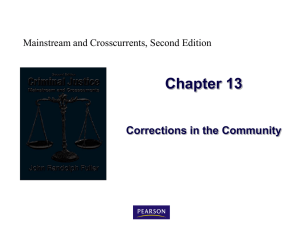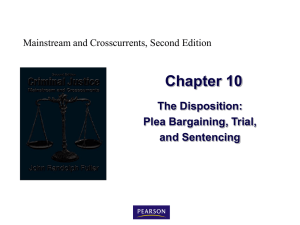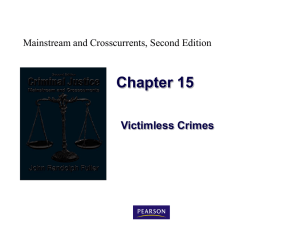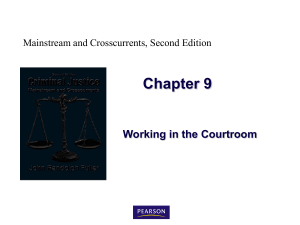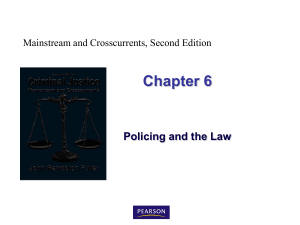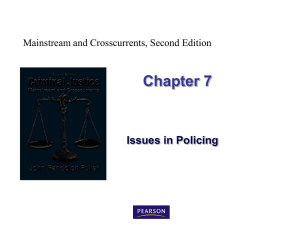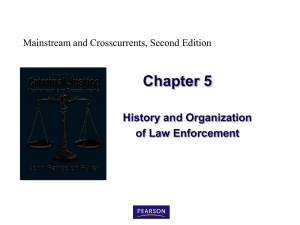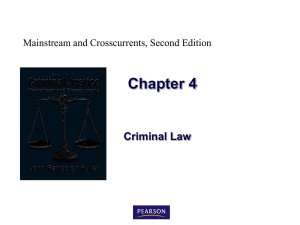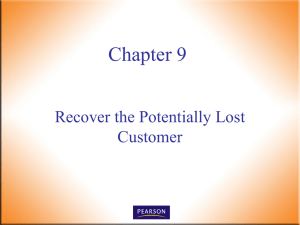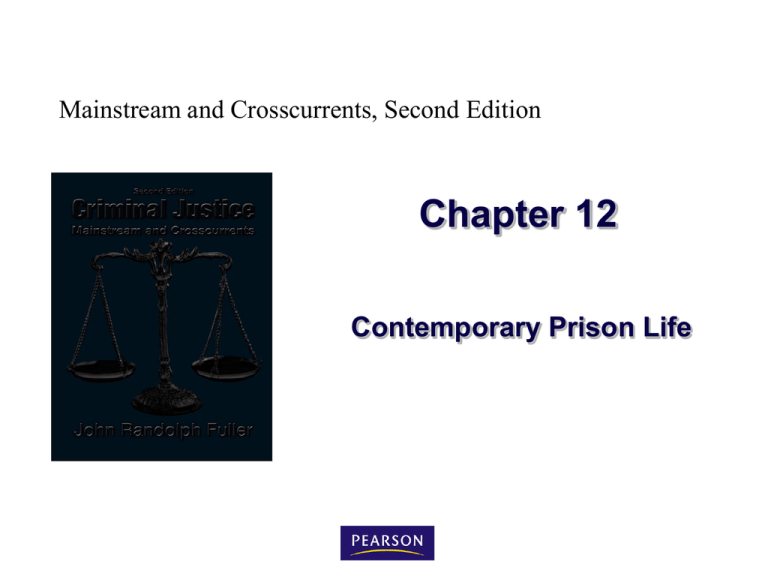
Mainstream and Crosscurrents, Second Edition
Chapter 12
Contemporary Prison Life
Prison life
The prison is a total institution, in
which everything is tightly controlled
and structured.
Criminal Justice: Mainstream and Crosscurrents, 2/e
John Randolph Fuller
2
© 2010 Pearson Higher Education,
Upper Saddle River, NJ 07458. • All Rights Reserved.
Prison life
Criminal Justice: Mainstream and Crosscurrents, 2/e
John Randolph Fuller
3
© 2010 Pearson Higher Education,
Upper Saddle River, NJ 07458. • All Rights Reserved.
Prison life
Sykes' five pains of imprisonment …
Deprivation of liberty
Deprivation of goods and services
Deprivation of heterosexual
relationships
Deprivation of autonomy
Deprivation of security
Criminal Justice: Mainstream and Crosscurrents, 2/e
John Randolph Fuller
4
© 2010 Pearson Higher Education,
Upper Saddle River, NJ 07458. • All Rights Reserved.
Prison life
Inmate subculture
Prison gangs
Supermax prisons
Prison riots and violence
Criminal Justice: Mainstream and Crosscurrents, 2/e
John Randolph Fuller
5
© 2010 Pearson Higher Education,
Upper Saddle River, NJ 07458. • All Rights Reserved.
Prison life
argot roles–Specific patterns of
behavior that inmates develop in
prison to adjust to the environment.
Criminal Justice: Mainstream and Crosscurrents, 2/e
John Randolph Fuller
6
© 2010 Pearson Higher Education,
Upper Saddle River, NJ 07458. • All Rights Reserved.
Prison life
Inmate subculture
Rats and center men
Gorillas and merchants
Wolves, punks, and fags
Ball-busters and real men
Toughs and hipsters
Criminal Justice: Mainstream and Crosscurrents, 2/e
John Randolph Fuller
7
© 2010 Pearson Higher Education,
Upper Saddle River, NJ 07458. • All Rights Reserved.
Prison life
Prison gangs
Mexican Mafia
La Nuestra Familia
Black Guerrilla Family
Aryan Brotherhood
Criminal Justice: Mainstream and Crosscurrents, 2/e
John Randolph Fuller
8
© 2010 Pearson Higher Education,
Upper Saddle River, NJ 07458. • All Rights Reserved.
Prison life
Supermax prisons
The modern supermax prison is
based on the federal penitentiary
at Marion, Illinois which the
Bureau of Prisons opened in 1969.
Marion became the first
standalone supermax prison in the
United States in 1983.
Criminal Justice: Mainstream and Crosscurrents, 2/e
John Randolph Fuller
9
© 2010 Pearson Higher Education,
Upper Saddle River, NJ 07458. • All Rights Reserved.
Prison life
Supermax prisons
Pelican Bay recalls the separateand-silent systems in the first
prisons in Pennsylvania
and Auburn, NY.
Criminal Justice: Mainstream and Crosscurrents, 2/e
John Randolph Fuller
10
© 2010 Pearson Higher Education,
Upper Saddle River, NJ 07458. • All Rights Reserved.
CrossCurrents Prison life
What’s wrong with supermax prisons?
The effects of incarceration are
severe.
Supermax prisons are expensive
and labor-intensive.
Criminal Justice: Mainstream and Crosscurrents, 2/e
John Randolph Fuller
11
© 2010 Pearson Higher Education,
Upper Saddle River, NJ 07458. • All Rights Reserved.
Prison life
Prison riots and violence
On rare occasions, the inmate's
frustrations are shared by others,
and the institution’s authority is
seriously challenged.
Criminal Justice: Mainstream and Crosscurrents, 2/e
John Randolph Fuller
12
© 2010 Pearson Higher Education,
Upper Saddle River, NJ 07458. • All Rights Reserved.
Prison life
Prison riots and violence
Attica prison riot
New Mexico State Penitentiary riot
Criminal Justice: Mainstream and Crosscurrents, 2/e
John Randolph Fuller
13
© 2010 Pearson Higher Education,
Upper Saddle River, NJ 07458. • All Rights Reserved.
CrossCurrents Prison life
Stanford prison experiment
Landmark experiment
Was the experiment ethical?
Shed light on human behavior
Criminal Justice: Mainstream and Crosscurrents, 2/e
John Randolph Fuller
14
© 2010 Pearson Higher Education,
Upper Saddle River, NJ 07458. • All Rights Reserved.
Working in the prison
The most prevalent job in the prison is
the correctional officer or guard.
Lombardo's seven variations of
correctional officer job assignments are…
Criminal Justice: Mainstream and Crosscurrents, 2/e
John Randolph Fuller
15
© 2010 Pearson Higher Education,
Upper Saddle River, NJ 07458. • All Rights Reserved.
Working in the prison
Block officers
Work-detail supervisors
Industrial shop and school officers
Yard officers
Administrative building assignments
Wall posts
Relief officers
Criminal Justice: Mainstream and Crosscurrents, 2/e
John Randolph Fuller
16
© 2010 Pearson Higher Education,
Upper Saddle River, NJ 07458. • All Rights Reserved.
Working in the prison
Correctional guard functions …
Human services
Order maintenance
Security
Supervision
Criminal Justice: Mainstream and Crosscurrents, 2/e
John Randolph Fuller
17
© 2010 Pearson Higher Education,
Upper Saddle River, NJ 07458. • All Rights Reserved.
Courts and the prison
Some opinions...
Inmates are protected by the
Constitution.
Inmate legal rights are not totally
restricted.
The rights lost by inmates should be only
those consistent with confinement and
maintaining institutional safety.
Criminal Justice: Mainstream and Crosscurrents, 2/e
John Randolph Fuller
18
© 2010 Pearson Higher Education,
Upper Saddle River, NJ 07458. • All Rights Reserved.
Courts and the prison
Before the 1960s, the courts cultivated
a hands-off doctrine toward
inmates' rights.
Cooper v. Pate (1964) began a new
era in prison litigation.
Criminal Justice: Mainstream and Crosscurrents, 2/e
John Randolph Fuller
19
© 2010 Pearson Higher Education,
Upper Saddle River, NJ 07458. • All Rights Reserved.
Courts and the prison
Eighth Amendment
Fourteenth Amendment: due process
Fourteenth Amendment: equal protection
Criminal Justice: Mainstream and Crosscurrents, 2/e
John Randolph Fuller
20
© 2010 Pearson Higher Education,
Upper Saddle River, NJ 07458. • All Rights Reserved.
CrossCurrents Courts and the prison
Incarceration and the Mentally Ill
As of 2005, more than half of all prison and jail
inmates reported a mental health problem.
Many communities lack the resources or the
organization to treat the mentally ill.
Criminal Justice: Mainstream and Crosscurrents, 2/e
John Randolph Fuller
21
© 2010 Pearson Higher Education,
Upper Saddle River, NJ 07458. • All Rights Reserved.
Courts and the prison
Eighth Amendment
"Excessive bail shall not be required,
nor excessive fines imposed, nor cruel
and unusual punishments inflicted."
Criminal Justice: Mainstream and Crosscurrents, 2/e
John Randolph Fuller
22
© 2010 Pearson Higher Education,
Upper Saddle River, NJ 07458. • All Rights Reserved.
Courts and the prison
Fourteenth Amendment
"No state shall make or enforce any law
which shall abridge the privileges or
immunities of citizens of the United
States; nor shall any state deprive any
person of life, liberty, or property, without
due process of law; nor deny to any
person within its jurisdiction the equal
protection of the laws."
Criminal Justice: Mainstream and Crosscurrents, 2/e
John Randolph Fuller
23
© 2010 Pearson Higher Education,
Upper Saddle River, NJ 07458. • All Rights Reserved.
Courts and the prison
Fourteenth Amendment: Due Process
The courts determined in Wolff v.
McDonnell (1974) that inmates are allowed
some due process.
Criminal Justice: Mainstream and Crosscurrents, 2/e
John Randolph Fuller
24
© 2010 Pearson Higher Education,
Upper Saddle River, NJ 07458. • All Rights Reserved.
Courts and the prison
Fourteenth Amendment: Equal Protection
The Fourteenth Amendment
addresses racial and gender-based
discrimination in the prison.
Discrimination prohibited in society is
also prohibited in correctional
institutions.
Criminal Justice: Mainstream and Crosscurrents, 2/e
John Randolph Fuller
25
© 2010 Pearson Higher Education,
Upper Saddle River, NJ 07458. • All Rights Reserved.
Courts and the prison
Fourteenth Amendment: Equal Protection
Constitutional expectations of privacy
are only partially available to inmates.
The inmate's body is a point of
contention.
Criminal Justice: Mainstream and Crosscurrents, 2/e
John Randolph Fuller
26
© 2010 Pearson Higher Education,
Upper Saddle River, NJ 07458. • All Rights Reserved.
Private prisons
Interest in privatizing prisons began
around the mid-1970s, and the first
modern private prisons opened in the
early 1980s.
With growing inmate populations,
many believe that private firms can
handle inmates more inexpensively
and efficiently.
Criminal Justice: Mainstream and Crosscurrents, 2/e
John Randolph Fuller
27
© 2010 Pearson Higher Education,
Upper Saddle River, NJ 07458. • All Rights Reserved.
Private prisons
The Increasing Imprisonment Rate
Criminal Justice: Mainstream and Crosscurrents, 2/e
John Randolph Fuller
28
© 2010 Pearson Higher Education,
Upper Saddle River, NJ 07458. • All Rights Reserved.
Private prisons
Arguments for private prisons
Money: Private organizations can run
prisons more cheaply.
Better employee control: More control
over hiring and firing
Flexibility and accountability
Criminal Justice: Mainstream and Crosscurrents, 2/e
John Randolph Fuller
29
© 2010 Pearson Higher Education,
Upper Saddle River, NJ 07458. • All Rights Reserved.
Private prisons
Arguments against private prisons
Money: Profit is more important than
inmates.
Better employee control: Staff have less
incentive to do a good job.
Control: Private prisons may refuse
difficult offenders.
Criminal Justice: Mainstream and Crosscurrents, 2/e
John Randolph Fuller
30
© 2010 Pearson Higher Education,
Upper Saddle River, NJ 07458. • All Rights Reserved.
Private prisons
State and local facilities still take in most inmates. As of 2006,
2.26 million inmates were in state and federal prisons and local
jails, an incarceration rate of 751 inmates per 100,000 US
residents.
Criminal Justice: Mainstream and Crosscurrents, 2/e
John Randolph Fuller
31
© 2010 Pearson Higher Education,
Upper Saddle River, NJ 07458. • All Rights Reserved.
Questions
What difficulties do prison staff and
officials face in dealing with prison gangs?
How are supermax prisons successful? In
what areas do they fall short?
To which constitutional amendments did
inmates turn to draw the courts’ attention?
Criminal Justice: Mainstream and Crosscurrents, 2/e
John Randolph Fuller
32
© 2010 Pearson Higher Education,
Upper Saddle River, NJ 07458. • All Rights Reserved.


